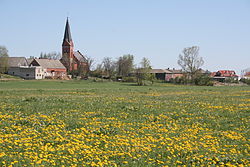world.wikisort.org - Poland
Złotoria [zwɔˈtɔrja] is a village in the administrative district of Gmina Lubicz, within Toruń County, Kuyavian-Pomeranian Voivodeship, in north-central Poland.[1] It lies approximately 8 km (5 mi) south-west of Lubicz and 8 km (5 mi) south-east of Toruń. It is located in the historic Dobrzyń Land.
Złotoria | |
|---|---|
Village | |
 Panorama of Złotoria with the Saint Adalbert church | |
 Złotoria  Złotoria | |
| Coordinates: 52°59′N 18°42′E | |
| Country | |
| Voivodeship | Kuyavian-Pomeranian |
| County | Toruń County |
| Gmina | Lubicz |
| First mentioned | 1242 |
| Population (approx.) | 1,700 |
| Time zone | UTC+1 (CET) |
| • Summer (DST) | UTC+2 (CEST) |
| Vehicle registration | CTR |
| Highways | |
| Voivodeship roads | |
The village has an approximate population of 1,700.
History

The village dates back to medieval Piast-ruled Poland. The oldest known mention in documents comes from 1242. In 1343, Polish King Casimir III the Great built a Royal castle in the village.
During the German occupation of Poland (World War II), in 1939, several Poles from Złotoria, including a teacher, farmers and sołtys (head of local administration) Bronisław Murawski, were murdered by the Germans during large massacres of Poles committed in the nearby Barbarka forest in Toruń as part of the Intelligenzaktion.[2] In November 1940, the German Schutzpolizei carried out expulsions of Poles, who were placed in a transit camp in Toruń, and then either deported to the General Government in the more eastern part of German-occupied Poland or sent to forced labour, while their houses and farms were handed over to German colonists as part of the Lebensraum policy.[3]
Notable people
- Robert Kłos (born 1982), retired Polish footballer
References
- "Central Statistical Office (GUS) – TERYT (National Register of Territorial Land Apportionment Journal)" (in Polish). 2008-06-01.
- Wardzyńska, Maria (2009). Był rok 1939. Operacja niemieckiej policji bezpieczeństwa w Polsce. Intelligenzaktion (in Polish). Warszawa: IPN. p. 162.
- Wardzyńska, Maria (2017). Wysiedlenia ludności polskiej z okupowanych ziem polskich włączonych do III Rzeszy w latach 1939-1945 (in Polish). Warszawa: IPN. pp. 79–80. ISBN 978-83-8098-174-4.
На других языках
- [en] Złotoria, Kuyavian-Pomeranian Voivodeship
[ru] Злоторя (Куявско-Поморское воеводство)
Злоторя — деревня в гмине Любич Торуньского повята Куявско-Поморского воеводства в центральной части севера Польши[1].Другой контент может иметь иную лицензию. Перед использованием материалов сайта WikiSort.org внимательно изучите правила лицензирования конкретных элементов наполнения сайта.
WikiSort.org - проект по пересортировке и дополнению контента Википедии